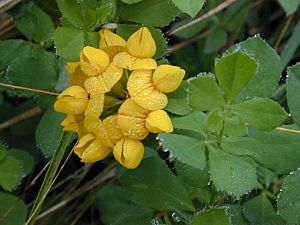Lotus pedunculatus facts for kids
Quick facts for kids Lotus pedunculatus |
|
|---|---|
 |
|
| Scientific classification | |
| Genus: |
Lotus
|
| Species: |
pedunculatus
|
| Synonyms | |
|
Lotus uliginosus Schkuhr |
|
The Big Trefoil (scientific name: Lotus pedunculatus) is a cool plant from the pea family, also known as Fabaceae. You might also hear it called the greater bird's-foot-trefoil or marsh bird's-foot trefoil. It's a type of plant that lives for many years.
Contents
What the Big Trefoil Looks Like
This plant grows all over Europe in places that are a bit wet and open. It's bigger than some of its relatives. The Big Trefoil can grow from about 20 to 80 centimeters (8 to 31 inches) tall. That's like the height of a small ruler to a large one!
Its leaves are made of smaller parts called leaflets. These leaflets are about 10 to 25 millimeters (0.4 to 1 inch) long and 10 to 20 millimeters (0.4 to 0.8 inches) wide.
The plant has beautiful golden-yellow flowers. There are usually five to twelve flowers in a bunch at the top of its stem. Each flower is about 10 to 18 millimeters (0.4 to 0.7 inches) long.
Special Features of the Big Trefoil
The Big Trefoil has some unique features that help you tell it apart. Its stem is always hollow inside. Also, the tips of its sepals (the small leaf-like parts that protect the flower bud) bend backward. These sepal tips create a cool "green star" shape at the end of the flower bud.
In the United Kingdom, you'll see the most Big Trefoil flowers in June and July.
Where the Big Trefoil Grows
You can find Lotus pedunculatus in many different damp and open places. It likes soils that are not too acidic or too alkaline. It often grows in wet meadows, like certain fen-meadows.
The Big Trefoil's Special Role
This plant is very important for a type of butterfly called the wood white butterfly (Leptidea sinapis). Female wood white butterflies lay their eggs on the Big Trefoil plant. This means the plant is a host for their young!
Images for kids
See also
 In Spanish: Lotus pedunculatus para niños
In Spanish: Lotus pedunculatus para niños


